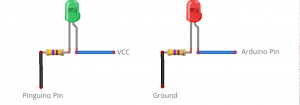Flashrom is an amazing piece of software and a life-saver when you need it! If you’ve tried to update your BIOS before using manufacturer supplied software and something went wrong, then you know how valuable Flashrom can be. I’ve written about Flashrom and the BusPirate in a previous post HERE. However, I just found out …
Category: Informational
Jun 20 2016
LM317 to output 3.3 Volts
I created a simple circuit using the LM317 to output 3.3 volts from a 5V or greater input voltage. Why? Because, a number of modules for the Arduino (or Pinguino) take 3.3 Volts. It’s true, some of the Arduinos do have a 3.3V voltage regulator (and thus a source of 3.3V), however, that might not …
Jun 01 2016
Serial Port Communication via Python
There are many Linux (and Windows) programs ‘out there’ that allow you to do serial port communications. However, I needed some things that those programs did not provide (on my Linux system) so I came up with my Serial Port Communication via Python script. If you want something that you can learn from and/or customize …
May 27 2016
FS1000A Wireless RF433 Transmit and Receive Module Pair
I like experimenting with wireless devices, as you can tell from the many posts about them here! 😎 I am trying out an FS1000A Wireless RF433 Transmit and Receive Module pair this time. They use use the RF 433Mhz frequency with ASK modulation. (You can also get these with the 315Mz frequency instead.) I got …
May 24 2016
NL6621-Y1 Wireless Module
There is a new kid on the block, the NL6621-Y1 Wireless Module from Nufront. The NL6621 WiFi SOC is powered by a 160 MHz ARM Cortex-M3 (NL6621M). Everything is integrated in the NL6621M SOC including 448KB of RAM. Here is what the NL6621-Y1 wireless module looks like: Supposedly it is …
May 20 2016
How to Power an LED (Arduino vs. Pinguino)
How to Power an LED (Arduino vs. Pinguino) might seem silly, however, if you take a look at the following graphic, you will hopefully notice something interesting. The Pinguino sources the power to the ‘user’ LED differently that does an Arduino. The Pinguino wiring is represented by the green LED and the Arduino wiring is …
May 13 2016
I2C Wire Chat Between Two Arduinos
Someone asked me the other day if it was possible to have a ‘chat’ between Arduinos using the I2C Wire library. I came up with ‘proof of concept’ code called ‘I2C Wire Chat Between Two Arduinos’. Here is the sketch: I2C Wire Chat Between Two Arduinos /* I2C wire chat From: earl@microcontrollerelectronics.com Analog Pin 5 …
Jan 22 2016
Arduino as a Network Monitor
I have set up an Arduino as a Network monitor so I can be silently alerted if a WEB server on the LAN/Internet goes down. In a previous post, here, I show the relay circuit I am using in this sketch to flash a CFL lamp. This sketch also uses the same ENC28J60 module to …
Jan 21 2016
Emergency Phone Call Alert to an Arduino via an Asterisk PBX
Recently, I created this simple circuit (and corresponding code) which makes an emergency phone call alert to an Arduino via an Asterisk PBX. This project was for someone who needed to be alerted (silently) if someone made an emergency phone call on their Asterisk PBX. By the way, the free and open source Asterisk PBX …
Dec 27 2015
Do-It-Yourself Pinguino PIC18F4550 Board
I just got a good deal on several PIC18F4550 chips. So, I decided to make a Do-It-Yourself Pinguino PIC18F4550 Board to test them out. The Pinguino boards are based on the same concept as an Arduino. However, instead of Atmel chips, Microchip PIC® chips are used. All of the Pinguino boards use PIC® chips with …









Recent Comments